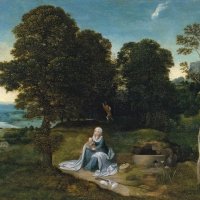Adam and Eve
Jan Gossaert, also known by the nickname of Mabuse after the city in which he was born, was an important Netherlandish painter active in the 16th century. He travelled to Italy and northern Europe and the influence of these journeys is clearly evident in his work. Gossaert was a key figure in the introduction of the Renaissance into the Low Countries. The present work, for example, is inspired by a print by Dürer on the same subject, as can be seen in the pose of Adam and Eve with the tree between them. Nonetheless, Gossaert introduced significant changes such as the direction in which the heads are facing. In the traditional manner, Adam is located on the left and Eve on the right, holding the apple that the serpent has given her. Gossaert produced numerous depictions of Adam and Eve, of which this version is considered the first. The panel was previously attributed to Dürer before being correctly given to Gossaert by Franz Dülberg. The date of this oil has been the subject of debate, but it is generally considered to have been painted during the artist’s time in Italy.
NR
As various authors have pointed out, the composition is indebted to Dürer’s engraving of Adam and Eve of 1504. However, Gossaert does not merely copy that work but reinterprets it to conform to his particular aesthetic concerns. The overall idea of two naked figures standing on either side of the Tree of Paradise is literally taken from Dürer’s print, as are the poses and gestures, but the rest of the composition is Gossaert’s own. He replaced Dürer’s leafy background with its numerous animals with a dense screen of undergrowth on the right and a tranquil, green landscape on the left with a path winding between low hills. The naked bodies of Adam and Eve are less muscular than in the engraving. They are presented in a similarly frontal manner but Gossaert modified the turns of the heads, which are in profile in Dürer’s original.
Gossaert depicted the subject of Adam and Eve on other occasions including the Malvagna Triptych in the Galleria Regionale della Sicilia in Palermo in which he was inspired by another print by Dürer from the Small Passion series of 1511, again altering the background and figures. Other examples on the subject are in the National Gallery, London, and the Gemäldegalerie, Berlin. There are drawings of this subject by the artist in the Devonshire collection, Chatsworth, the Albertina, Vienna, the Rhode Island School of Design, Rhode Island, and the Kunstinstitut, Frankfurt. The present panel with its arched top is the first known example of this subject in Gossaert’s oeuvre.
The date of its execution has been of some debate, as has its relation to the trip that Gossaert made to Italy between 1508 and 1509 on a diplomatic mission for Philip of Burgundy. Held considered that the painting was made after that trip as it uses rules of proportion derived from classical art and from the Italian Cinquecento, which Gossaert would have learned while in Italy. As a result, the painter freed his depiction from the theoretical connotations to be found in other versions of the subject and instead focused on other aspects.
Aside from these fine points, both this oil and others in which the artist painted the nude (which he frequently depicted throughout his career) were crucial for the subsequent development of the genre as they were the first depictions of nudes in Flemish art. With regard to the present panel, Colin Eisler drew attention to the allegorical significance of some of the plants and flowers around the two figures and which can be interpreted in relation to Original Sin.
Mar Borobia











